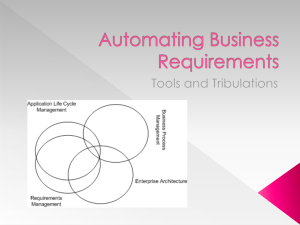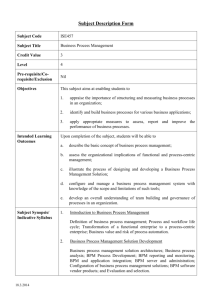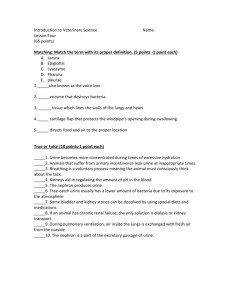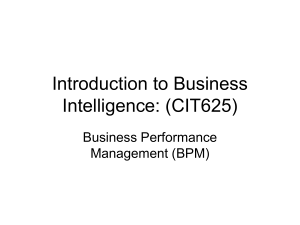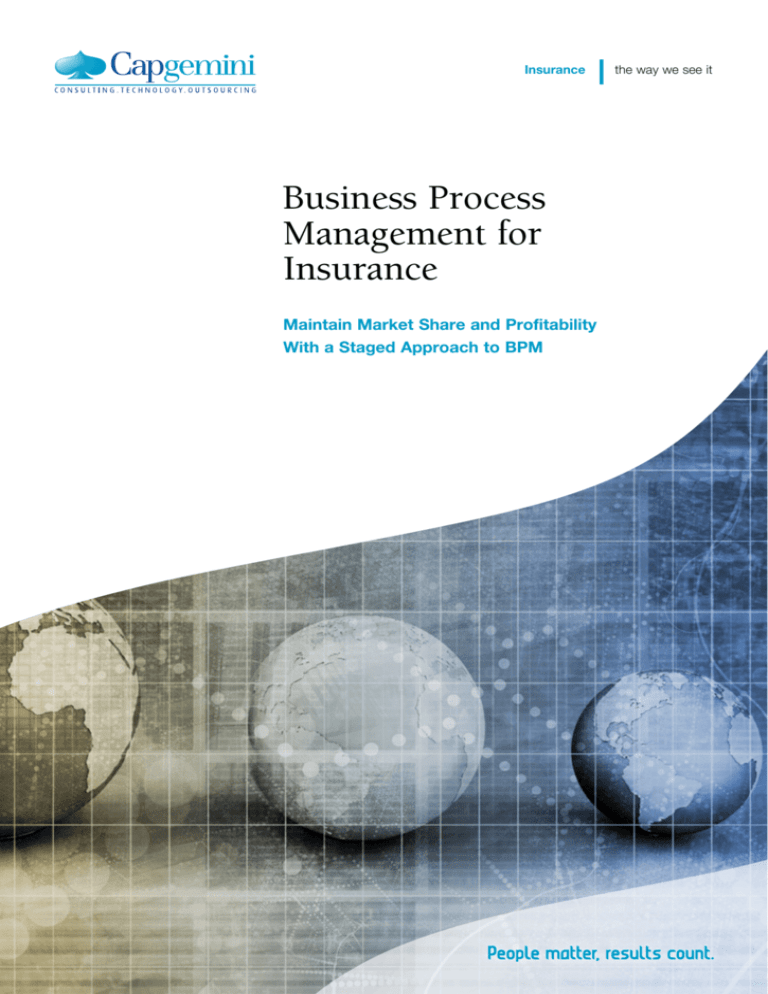
Insurance
Business Process
Management for
Insurance
Maintain Market Share and Profitability
With a Staged Approach to BPM
the way we see it
Contents
1Introduction
3
2 Business Process Management: Trends & Advantages
4
2.1 What is Business Process Management?4
2.2 Why Use Business Process Management?6
3 Business Process Management: How Can It Help Insurers?
7
3.1 The Emerging Focus of Insurance Companies Worldwide7
3.2 BPM in the Front Office7
3.3 BPM in Underwriting8
3.4 BPM in Claims8
4 The Controlled Migration Approach to BPM for Insurers
5Conclusion
2
9
11
the way we see it
1Introduction
Over the years, companies have maintained a competitive edge by improving
and optimizing their business processes without compromising efficiency, quality,
and response time.
Since the Industrial Revolution, process management techniques have continuously
evolved, from process definition and workflow management to process
improvement and reengineering to today’s business process management (BPM).
While other industries have adopted BPM for their core processes, the insurance
industry has been reluctant to implement BPM in its core areas like underwriting
and claims. Lately however, insurers have come to appreciate the advantages and
successes of BPM, and are implementing it at a growing rate.
In this paper we explore the BPM market and its latest trends, and identify the
advantages that BPM can provide to the insurance industry. We then take a look at
the challenges that an insurer can face while implementing BPM and how they can
achieve an effective BPM implementation.
Business Process Management for Insurance
3
2 Business Process
Management:
Trends & Advantages
The BPM market is expected to grow at a rapid pace (12.2%1) over the next few
years with emerging markets such as Asia Pacific and Middle East & Africa leading
the way. BPM providers are consolidating with only 25 BPM vendors in 2009
compared to 150 in 2006.2
BPM is set to become a major force driving various industries across the globe,
including financial services:
By 2012, an estimated 20% of customer facing processes will be assisted by BPM.
■ By 2014, an estimated 40% of business managers and knowledge workers in
Global 2000 enterprises will use comprehensive BPM models to support their
daily work, up from 6% in 2009.3
■
According to BPM industry research4, 94% of the firms surveyed have already
implemented BPM or have plans to implement BPM initiatives within the next
three to five years. Only 6% of the firms interviewed had neither implemented, nor
planned to implement, BPM initiatives.
This research indicates that most companies across all industries have been adopting
BPM. Rather than being a differentiating factor, it is turning very quickly into a core
strategy for firms to maintain their competitiveness.
2.1.What is Business Process Management?
Business process management helps an organization to monitor and optimize
their processes continuously. While each company’s processes and needs are
different, BPM enables any organization to enhance its operational efficiencies on a
continuous basis, thereby providing a competitive advantage.
There are many ways to define BPM and generally the definition depends on the
context. For example, Gartner defines it as a “…management discipline that treats
business processes as assets that directly improve enterprise performance
by driving operational excellence and business agility.”5 PC Magazine defines it as
“A structured approach that models an enterprise’s human and machine tasks and
the interactions between them as processes.”6
In Capgemini’s experience, BPM can best be described as a set of activities carried
out by organizations to optimize their business processes and/or adopt their
business processes to new organizational goals. Here, a business process is defined
as a series of coordinated actions, conducted by both people and tools, resulting in
the accomplishment of a specific organizational goal.
1
2
3
4
5
6
4
Business Process Management: Global Market Forecast Model to 2014, Datamonitor
“Magic Quadrant for Business Process Management Suites”, Gartner 2009
Research Conducted by Gartner, http://www.gartner.com/it/page.jsp?id=1278415
Research conducted in 2009 by Transformation & Innovation in conjunction with BPM Education Associates, BPM.com
and the Workflow Management Coalition on 500 firms.
Gartner IT Glossary, http://www.gartner.com/technology/it-glossary/business-process-management.jsp
PC Magazine Encyclopedia, http://www.pcmag.com/encyclopedia_term/0,2542,t=BPM&i=38884,00.asp
the way we see it
The Next Wave for BPM: Integrating
with Business Intelligence and Analytics
Business intelligence and analytics enable decision makers to gain a better
understanding of the current state and the desired state of their business
processes. Common analytics include:
Historical Data Analytics looks at past and current data to make it easy to
understand.
■ Trend Analytics looks at current data to uncover trends which can help
redesign a process.
■ Predictive Analytics helps to determine future decisions based on
predictions made using past and current data trends which enables the
design of a new process for future use.
■
Once the current and desired state of processes is determined, BPM serves as
the foundation to build the required changes.
Stand-alone implementations of BPM, business intelligence, and analytics
can yield numerous advantages. But organizations can maximize benefits
by leveraging synergies between these areas. In fact, according to a recent
survey of 335 IT leaders by CIO.com7, 65% of the respondents indicated that
business intelligence and analytics spurred the business process changes and
the need to implement BPM but only 41% indicated that they had actually
integrated both these disciplines. Organizations still need to take the next step
forward to integrate BPM, business intelligence, and analytics to ensure a new
wave of benefits.
Exhibit 1: Integration of Business Intelligence and Analytics with BPM
BI/Analytics
Historical
Data
Analytics
Predictive
and Trend
Analytics
Enables
Enables
Understanding of the
Current Processes
Understanding of the
Desired Processes
Accelerated Process
Changes/Optimization
BPM
Source: Capgemini Analysis, 2011
7
Business Process Management for Insurance
CIO.com article http://www.cio.com/article/597059/Business_Intelligence_Meets_BPM_Using_Data_to_Change_
Business_Processes_on_the_Fly
5
2.2.Why Use Business Process Management?
Business process management has helped financial services firms realize numerous
benefits related to operational efficiency and business innovation. Moreover, many
firms claim8 that they have achieved a more than 100% rate of return on their
BPM implementations. While the methods used to measure rate of return vary
according to the firm, the most widely used method among firms is ‘cost savings
per transaction’.
2.2.1.Operational Efficiency
Enhance employee productivity. BPM helps automate manual tasks, freeing
employees to focus on higher value activities.
■ Speed-up processes. BPM enables faster decision-making and improves the
operation of all business processes.
■ Increase partner responsiveness. BPM tools allow partners to get on board and
respond faster.
■ Better manage inventory. BPM brings improvements in processes that result in
superior inventory management.
■
2.2.2.Business Innovation
Enhance product capabilities. Using BPM results in agile product design and an
improved ability to implement new products.
■ Increase new business. BPM enables innovative ways to approach a business
problem and can help bypass traditional obstacles.
■ Raise customer service levels. BPM enables faster and more flexible responses
to customer needs and queries, and improves the accuracy and quality of
customer service.
■
8
6
Research conducted in 2009 by Transformation & Innovation in conjunction with BPM Education Associates, BPM.com
and the Workflow Management Coalition on 500 firms
the way we see it
3 Business Process
Management: How
Can It Help Insurers?
While most of the challenges faced by insurance companies are similar to the
challenges faced across all industries, insurers must particularly focus on increasing
cost effectiveness and better managing risk. At the same time, insurers must
enhance agent and client satisfaction to increase market share. It is important
that the underlying IT systems supporting insurance transactions or processes are
streamlined, agile, and flexible. Insurers can strategically leverage BPM technology
to bring agility to IT systems and address other industry challenges.
3.1.The Emerging Focus of Insurance Companies Worldwide
Over the past two to three years, interest in business process management has
been rising among property and casualty and life insurers. To date, adoption of
BPM is higher in North America and starting to rise steadily in other regions such
as continental Europe and Asia with the realization of cost savings and process
efficiencies. Many of the largest global insurance firms are spending over $10
million annually on BPM9.
Major BPM initiatives for property and casualty insurance involve front office,
underwriting, and claims processes. Two key areas where life insurers are beginning
to use advanced BPM capabilities are underwriting and new business processes.
3.2.BPM in the Front Office
Business process management enhances front office operations by enabling an
insurer to handle agents more effectively, optimize multiple distribution channels,
and enhance the probability of renewals and new business.
Exhibit 2: Benefits of BPM in the Front Office
Benefit
Impact
More effective agency/
carrier management
Top and
bottom line
BPM Helps Insurers…
Introduce various insurance options to
customers
■
Monitor performance of distribution channels
■
Update agent compensation management
■
Multi-distribution
channel optimization
Top and
bottom line
Adopt new channels faster and integrate them
with existing channels
■
Introduce and quickly update the rules for a
particular channel
■
Support a smoother flow of data and
information between channels
■
Enhanced new
business/renewal
management
Top line
Automatically initiate policy renewals
■
Support enhanced prospect identification and
automatic quote generation in combination with
business intelligence and analytic tools
■
Source: Capgemini Analysis, 2011
9
Business Process Management for Insurance
BPMtrends.com
7
3.3.BPM in Underwriting
Business process management can lead to significant bottom-line and top-line
impact for an insurance firm by enabling increased transparency for underwriting
and policy administration and effectively and efficiently aligning underwriting with
the company’s goals.
Exhibit 3: Benefits of BPM in Underwriting
Benefit
Impact
Decreased
operating expense
Bottom
line
BPM Helps Insurers…
Achieve rule-driven decision-making and straightthrough processing
■
Support consistency and better performance
metrics (business activity monitoring)
■
Enhance business user experiences leading to
better productivity and job satisfaction
■
Improve compliance to regulations
■
Decreased IT
expense
Bottom
line
Increased
premium income
Top line
Build configurable underwriting systems to lower
maintenance and support costs
■
Enhance ability to issue policies, leading to
enhanced customer and agent experiences
■
Source: Capgemini Analysis, 2011
3.4.BPM in Claims
Implementing business process management for claims can provide an effective way
to process claims and manage risks. BPM can reduce overall claims processing time
and better manage third parties.
Exhibit 4: Benefits of BPM in Claims
Benefit
Impact
Enhanced
claims handling
effectiveness
Bottom
line
BPM Helps Insurers…
Automate claims routing to claims adjustor
■
Enhance claims adjustor experience through better
work assignments
■
Improve compliance to regulations
■
Reduced claims
processing time
Bottom
line
Effective risk
management
Bottom
line
Enable straight-through processing for intimation of
claims by customers/agents
■
Effectively manage fraud in co-ordination with
predictive analysis (business intelligence)
■
Support a smoother flow of data and information
across various departments within and outside claims
■
Improved third
party management
Top and
bottom line
Increased
customer
acquisition and
retention
Top line
Seamlessly integrate real-time with third party
processes and systems such as vendors and
regulatory authorities
■
Enhance service for customers across multiple
touch points: prompt and equitable claims
settlement and flexible pay out options
■
Effectively manage data and support better decision
making to improve underwriting risks
■
Create claims experience-based competitive pricing
of risks leading to enhanced customer acquisition
■
Source: Capgemini Analysis, 2011
8
the way we see it
4 The Controlled
Migration Approach to
BPM for Insurers
Traditionally, BPM has faced challenges in the insurance industry as insurers have
been hesitant to implement BPM over critical core processes such as underwriting
and claims. While implementing BPM, insurers are always faced with the difficult
decision of choosing a “big bang” approach versus an incremental approach that
uses stages. There has been limited clarity on the use of BPM in insurance and a
perception of high cost.
BPM implementations require a coordinated and committed team of crossfunctional experts to integrate new systems with existing ones. Because of these
challenges, many insurers restrict the scope of their BPM implementations. To
mitigate the risk of a large scale BPM implementation effort, a ‘controlled migration’
methodology might be helpful.
Controlled migration is a step-by-step process-managed approach to help
insurers achieve a successful application landscape for the future. A traditional
application landscape is rigid, complex, and has duplicate functionality. Through
an incremental ROI-driven process, insurers can gain lower costs, increased agility,
and increased transparency in core systems.
Exhibit 5: Controlled Migration of Current Insurance Systems to BPM-Enabled Systems
Traditional Application Landscape is rigid,
complex and has duplicate functionality
An incremental ROI driven
process with a big outcome
■
Lower costs
■
Increased agility
■
Increased transparency
Business Process Management System
Source: Capgemini Analysis, 2011
Business Process Management for Insurance
9
Controlled migration can help insurers:
Take small steps to migrate from legacy platforms to SOA-enabled, BPM insurance
systems, thereby reducing resistance to change.
■ Effectively integrate with other systems to keep the insurance systems up and
running during the implementation to avoid any system downtime leading to loss
of business.
■ Optimize the use of existing assets rather than completely discarding them.
■ Ensure optimal use of resource time through a phased approach to
implementation.
■ Manage and re-confirm expectations at each step of the controlled migration
process.
■
Controlled migration of current systems to SOA-enabled BPM systems can minimize
the risk faced during system migrations and reduces overall cost for an insurer.
IN PRACTICE: Rapidly achieving
business value using an iterative
approach to claims transformation
Our client, a leading North American insurer, wanted to reduce operational
expenses and improve the customer experience for the first notice of loss
(FNOL) process. The legacy systems handling the functionality lacked
flexibility and agility to respond to changing business needs. In addition, the
insurer was dependent on manual interventions which relied heavily on the
knowledge of experienced employees. With acquisitions planned as part of the
company’s growth strategy, the insurer wanted to plan for future integrations
to the system.
Capgemini is delivering an agnostic FNOL front end across lines of business
and business units in a staged manner using PegaRULES Process Commander®
BPMS technology. The system is on track to achieve operational savings that
are 2x the original plan.
10
the way we see it
5 Conclusion
In the intensely competitive insurance market, differentiation through innovative
technologies like BPM is an important and effective way to maintain or increase
market share and profitability. Insurers can achieve numerous qualitative and
quantitative advantages across the value chain by implementing BPM.
The ‘Controlled Migration’ approach helps insurers’ lower risks and overcome the
challenges of a BPM implementation for core processes so insurers can reap the
benefits of a successful business process management.
Business Process Management for Insurance
11
www.capgemini.com/insurance
About the Author
Chirag Thakral is a Lead Consultant in Capgemini’s Strategic Analysis Group
within the Global Financial Services Market Intelligence team. He has over seven
years of experience in strategy, business, and technology consulting for financial
services clients across insurance, banking, and capital markets.
The author would like to thank Gaurav Mathur, Sree Rama Edara,
Ravi Bommakanti, William Sullivan, and David Wilson for their contributions
to this publication.
About Capgemini and the
Collaborative Business Experience
Capgemini, one of the
world’s foremost providers
of consulting, technology and outsourcing
services, enables its clients to transform
and perform through technologies.
Present in 40 countries, Capgemini reported
2010 global revenues of EUR 8.7 billion and
employs around 112,000 people worldwide.
Capgemini’s Global Financial Services
Business Unit brings deep industry
experience, innovative service offerings and
next generation
global delivery to serve the
and
the
financial services industry.
Capgemini provides its clients with
insights and capabilities
that Capgemini
boost their
About
freedom to achieveCollaborative
superior results
Business Experience
through a unique way of working, the
With a network of 18,000 professionals
Collaborative Business Experience™.
servingin
over
clientsCapgemini
worldwide,reported
Present
40 900
countries,
Capgemini, one of the
Capgemini
collaborates
with
banks,
2010 global revenues of EUR leading
8.7 billion
and
world’s
foremost
providers
The Group relies
on its
global delivery
insurers
and
capital
market
companies
to
®and outsourcing
employs
around
112,000
people
worldwide.
ofmodel
consulting,
technology
called Rightshore , which aims to
deliver business and IT solutions and thought
services,
enables
its clients
transform
get the right
balance
of thetobest
talent
Capgemini’s
Globalcreate
Financial
Services
leadership which
tangible
value.
and
through
technologies.
fromperform
multiple
locations,
working as one
Business Unit brings deep industry
team to create and deliver the optimum
For more information
please visit
experience,
innovative service
offerings and
Capgemini provides its clients with
www.capgemini.com/financialservices
solution for clients.
next
generation
global
delivery
to serve the
insights and capabilities that boost their
financial
services
industry.
freedom to achieve superior results
through a unique way of working, the
With a network of 18,000 professionals
™
Copyright
© 2011
Capgemini.
All rights
Collaborative
Business
Experience
. reserved.
serving over 900 clients worldwide,
Capgemini collaborates with leading banks,
The Group relies on its global delivery
insurers and capital market companies to
model called Rightshore®, which aims to
deliver business and IT solutions and thought
get the right balance of the best talent
leadership which create tangible value.
from multiple locations, working as one
team to create and deliver the optimum
solution for clients.
For more information please visit
www.capgemini.com/financialservices
Copyright © 2011 Capgemini. All rights reserved.




